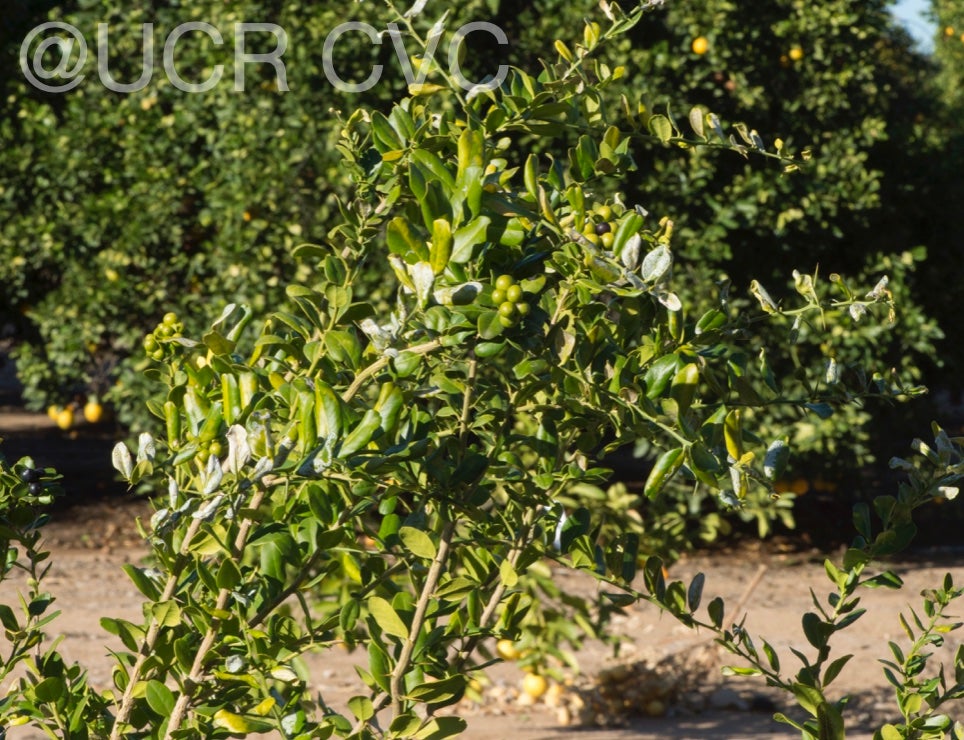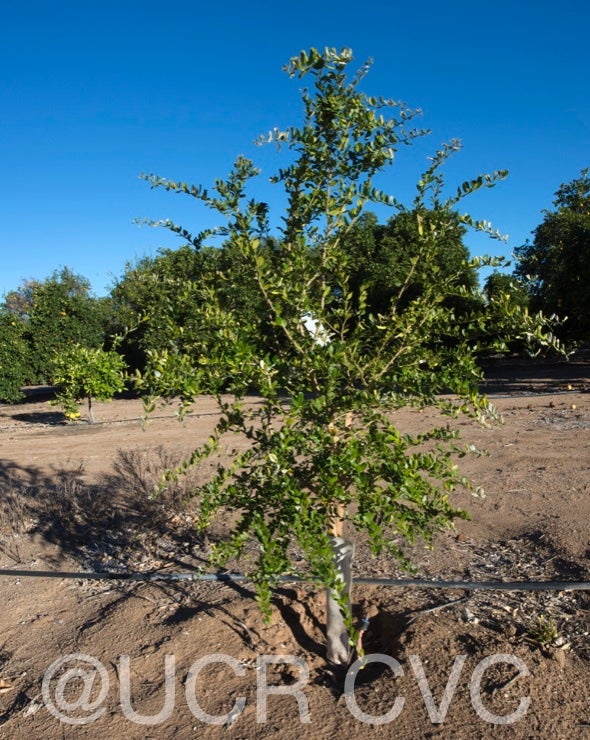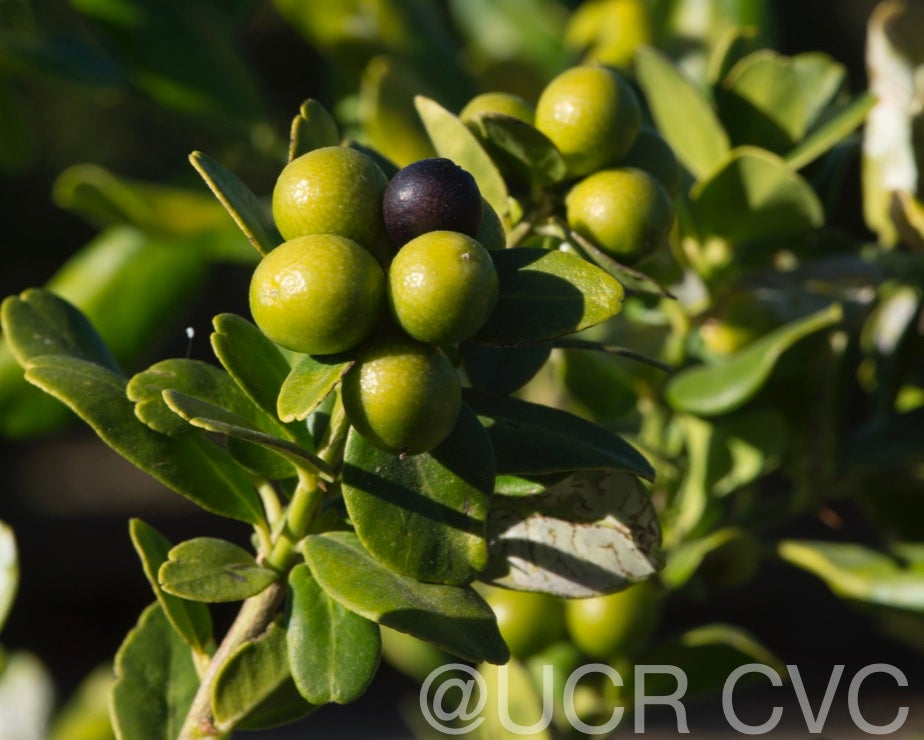Chinese box orange
CRC 1495
PI 539796
Source
Received as a cutting from W.T. Swingle, USDA, 1924.
Parentage/origins
Reported to be from Indochina.
Rootstocks of accession
Own roots.
Season of ripeness at Riverside
Year-round
Season of flowering at Riverside
September to October
Description from The Citrus Industry Vol. 1 (1967)
"Bentham's description (1851, p. 326) may be translated as follows: "Low shrub, or in our gardens dwarf tree, branches spreading, young twigs obscurely angular or somewhat compressed, always puberulous, soon glabrous and terete. Spines axillary, strong, usually much shorter than the leaves, only rarely longer. Leaves 1-1 1/2 in. [2.5-3.8 cm] long, 6-9 lin. [12-18 mm] wide, obtuse, narrowed at the base into a short, narrow, rounded petiole, coriaceous, rigid, densely dotted with oil glands, glabrous, with numerous parallel veins arising from the midrib, much more conspicuous than in many species [of Sclerostylis = Atalantia]. Flowers between small bracts in the axils of the leaves, sessile, or rarely borne on a very short pedicel, never solitary, usually 2-3-fasciculate. Calyx widely campanulate, short, smooth, with 5 rounded, very obtuse lobes. Petals 5, scarcely 2 lin. [4 mm] long, oblong, erect, glabrous. Stamens 10, shorter than the corolla, filaments dilated, attenuate at the apex, anthers ovate, parallel locules. Ovary sessile on a cupulate disk, subglobose, fleshy, with small locules in the centers, ovules attached to the central axis slightly below the apex. Style very short, stigma thick, ovoid, pulvinate. Berry depressed globose, becoming black at maturity, seeds large, ovoid."
The original description of Poiret (1797, pp. 580, 581) reads, in translation, as follows: "Citrus buxifolia, leaves subsessile, ovate-retuse, flowers racemose, very small…I do not know its height, but the branches I have examined in the herbarium of Citizen Lamarck, would indicate that it is not tall. With its short, stiff branches, its spines and the shape and firmness of its leaves, it has the aspect of Rhamus pyracantha. The wood is hard, white, with a smooth green bark. It has many spreading branches with stiff straight spines, yellowish at the tips. The leaves are few, alternate, oval, almost sessile, much like those of box, but twice as large, obtuse at the apex, emarginate, narrowed at the base, remarkable by the very close veins, which are prominent and parallel, coriaceous, with entire margins. The petioles are simple and very short. The flowers occur in small bunches toward the ends of the branches. The corolla is white and very small. This plant is native to China and was observed there by Sonnerat, who sent the specimens to Citizen Lamarck."
This, the type species of the genus Severinia, is not an uncommon plant in wooded areas in southern China as far north as the Tropic of Cancer. It is also found in Hong Kong and Hainan, and in Indo-China from the northern border of Laos and North Vietnam to latitude 10° S. It is a small, spiny tree with crooked, thorny branches and dense, evergreen foliage. It is esteemed by the Chinese for its leaves, which are used in making yeast cakes. For this reason it is called 'tsau 'ping lak in Cantonese, meaning "wine cake thorn."
A careful search for variations in S. buxifolia, made by G. W. Groff and F. A. McClure, formerly of the Horticultural Department of Lingnan University at Canton, led to the discovery of many forms of the species differing in height, character of growth, size and shape of the leaves, number and length of spines, et cetera, and also in physiological characters, such as congeniality with Citrus in grafting experiments. So far, none of these forms have been given taxonomic names, but some appear so distinct that when they are studied more carefully it may prove desirable to recognize them as subspecies, varieties, or forms.
Certain broad-leaved forms growing near the seashore at Da Nang (Tourane) in South Vietnam (Lat. about 16° N.) have shown not only great vigor under culture but also high resistance to boron and injurious saline solutes often found in the ground water where Citrus is grown in semiarid situations.
Inasmuch as Citrus can be grafted readily on S. buxifolia, and since some plants so grafted have lived over thirty years without showing any sign of bad graft union, it is clear that more study should be given to the use of this species as a rootstock. Besides its important physiological distinction from Citrus in respect to boron absorption and sensitivity toward saline solutes in the ground water, the very fact that S. buxifolia is so remote a relative of Citrus as to be quite immune to many Citrus diseases recommends it for trial as a rootstock.
With regard to the relative boron tolerance of the lemon and the box-orange, Eaton and Blair (1935, p. 413) stated: "The lemon (Citrus limonia Osbeck) is highly sensitive to boron; in fact few plants are thought to be more sensitive, and it accumulates much boron in its leaves. The Chinese box orange, Severinia buxifolia, on the other hand, in confirmation of the observations of Swingle, Robinson, and May, is relatively tolerant to boron. Severinia has been found to accumulate much less boron in its foliage than does the lemon."
Eaton and Blair conducted experiments on boron tolerance of the lemon and of the Chinese box-orange, as well as of reciprocally grafted plants (i.e., lemon on box-orange roots and box-orange on lemon roots) which Swingle supplied them with the help of Eugene May, Jr. Striking proof that the box-orange has much higher resistance to boron-poisoning than the lemon is given in their Table II reproduced below.
Eaton and Blair commented as follows on the data presented in the table: "Lemons [grafted] on box orange roots had about one-third as much boron in their leaves as when grown on their own roots. The data indicate that the boron concentrations in the box orange leaves are increased threefold when the plant is grown on lemon roots. There were no box orange plants on their own roots in the 2 and 4 ppm cans, but the plant in 6 ppm on its own roots had 390 ppm, whereas the box orange on lemon roots in 4 ppm had 877 ppm of boron in its leaves. Lemon leaves on their own roots were more severely injured than when on the box orange roots."
This record of experiments, made after years of experience in growing Citrus in nutrient solutions containing known amounts of boron, is of great value in showing the striking difference in the toxicity of boron for Citrus roots and for Severinia roots, although both genera of plants grow wild in situations that are similar with respect to both climate and soils. (See also discussion of boron tolerance of Eremocitrus.)
The possibility of growing Citrus on a plant as remote, taxonomically, as the box-orange has served to direct attention to the need of testing all the wild relatives of Citrus in the hope of finding others able to thrive as the box-orange does, in physical and biological environments that Citrus roots cannot endure, and at the same time able to serve as rootstocks for the commonly cultivated species of Citrus."
Availability
Not commercially available in California.
USDA Germplasm Resources Information Network page for Severinia buxifolia (CRC 1495)




